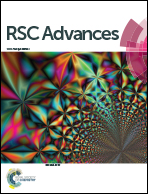Rheological properties of a β-1,3-polyglucuronic acid derivative from 4-acetamido-TEMPO-mediated oxidation of curdlan
Abstract
The rheological properties of a carboxylic curdlan bearing a β-1,3-polyglucuronic acid structure were investigated as a function of concentration and temperature. Carboxylic curdlan solutions exhibited shear thinning behavior that became more evident with increasing concentration. This behavior was further described by a consistent index (k) and a flow behavior index (n) based on the power law model. Activation energy (Ea) decreased with increasing concentration, as calculated by the Arrhenius rule. The mechanical spectra of carboxylic curdlan were classified as dilute solution (<1.0%, w/v), entanglement network (2.0%, w/v), and weak gel (4.0%, w/v or above) according to frequency sweep, complex viscosity η*, and tan δ results. Moreover, changes in the storage modulus (G′) and the loss modulus (G′′) were found to be dependent on frequency and concentration. This finding suggested that carboxylic curdlan could be explored as a potential thickener or stabilizer for various applications in the food industry.



 Please wait while we load your content...
Please wait while we load your content...